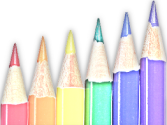Getting to Know You Newspaper
Getting to Know You Newspaper
Grade Level(s): 8
Key Words: Interviewing for a News Story, Technology
Developer(s) Name: Pamela E. McKnight
School: Washington Irving Middle School
Approximate Time Frame:
Materials/Equipment
Needed:
Description of Lesson (includes
context):
- What is the objective of this lesson?
Students will use oral language skills to acquire information; they will evaluate the
effectiveness of their questions; and they will engage in the writing process as they
formulate the information into a news story using word processing skills on the computer.
What will we examine as evidence of students' knowledge and/or skill?
What exactly will the students and teacher do during the lesson?
- Write ten open-ended questions to ask your interviewee.
Remember that the objective
is to get as much information as possible. - As you ask the questions, use appropriate eye contact, voice
level, and body language.
You want to make the interviewee feel comfortable and not threatened or intimidated.
Seem genuinely interested and friendly while encouraging the person to respond. - Record the person's responses listening for direct quotes. You
will want to have at
least two direct quotes in your news story, so listen for words that really express the
interviewee or convey a main point. It is important to have the person's voice in the
story because it makes it more authentic; it's as if the person can be heard. While
recording the responses, also note the person's body language, mannerisms, and voice
tone. People speak non-verbally and these cues will be helpful. For example, while
asking a question, if the person begins to bite his/her lip this may mean that this is a
difficult/painful topic or if the person uses a lot of gestures this might mean the person
is very energetic or expressive. - Review your responses, and then pick one subject to write
about. You want to have a
focus to the news story, so you need to select one topic and then develop at least ten
new questions that focus on that specific topic. For example, if the interviewee
mentioned sports, make up new questions specifically about the sport that they play or
a specific game. - Record the new responses and direct quotes that you will use in the news story.
- Decide if you will write a front-page news story or a feature story.
- Using ClarisWorks make a two-column document and insert a
header for the title of
your story. Then begin drafting the story. - Revise draft for content to include a better lead, more
elaboration, improved word
choice and sentence structure and variety. - Peer conference with your partner and review suggestions.
- Make changes and print a second draft.
- Edit for grammar, capitalization, punctuation, and spelling. Peer conference again.
- Insert graphic and make sure it is the size that you desire.
- Print final copy and turn in all work.
- Prepare students to write news stories by discussing and
bringing in examples of front-
page stories and feature stories. Explain that most of the front-page stories use the
inverted pyramid format and are usually about something that happened with the most
important details at the beginning. A feature story will highlight a person's life or
something about the person's life or accomplishments with the best details toward the
end of the story. Also discuss that a good lead is necessary to attract a reader's
attention. - Give each student a partner to interview. I would recommend
that the teacher have
students pull names from a hat or use some other arbitrary method. I would not allow
students to choose their partners because some students may choose people that they
10. Plan to be in the computer lab three days. In the computer lab
instruct students how to
11. As students are drafting, teacher should take a picture of each
student with the digital
12. Instruct all students on how to insert a graphic/photo into their
documents. However,
13. During the three days in the computer lab students will take
turns going to the extra
14. Once students have completed the writing process they are ready
to print their final
15. Have students share the news stories and present them at a team
function or at a parent
What options in presentation(s) and/or response(s) are suggested in order to provide the opportunity for all students to demonstrate achievement of the benchmark(s) and indicator(s)?
The teacher could provide students with a few starter questions or
allow the students to write
The teacher could shorten the length of the assignment by
decreasing the number of required
The teacher could provide students with an outline of what should be in each paragraph. The teacher could allow students to record responses instead of writing them.
The teacher could enlist the help of the ESL specialist to explain and model non-verbal cues that
ESL students might not be aware of.

